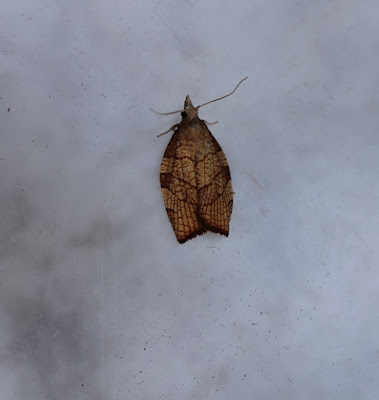 |
| Ruby Tiger (Phragmatobia fuliginosa) |
The Ruby Tigers seen in the garden at Shandy Hall have all been bright red. This one could be the variant sub-species borealis with its forewings more of a woody brown. There is a pink tinge to the wings on this specimen but there is also one clearly displayed, ruby-coloured front leg. The scientific name is slightly odd - phragmatobia translates as living (bio) on a fence (phragmatos). As this moth often flies by day it might simply refer to where the moth was first encountered - on a fence. The shape resembles the Muslin moth and the black spots reinforce this.
 |
| Common Carpet (Epirrhoe alternata) |
Not as common a moth as its name suggests - although that might just be this locality. I thought this was a Wood Carpet (Epirre rivata) but I was mistaken as that moth has not yet been recorded in this neck of the woods.
The Common Carpet overwinters as a pupa and can be found in a variety of habitats from hedgerows to sand-dunes and from gardens to moorland.
 |
| Chequered Fruit-tree Tortrix (Pandemis corylana) |
Immediate identification is sometimes straightforward but often not. Sometimes there is a feeling that the moth has been seen in previous moth-traps even if the name of the species has been forgotten. This little moth with wing -markings like a network, was walking purposefully amongst the dozens of Underwings hiding in the egg-boxew. It looked new to me but I couldn't be sure what species it was. Confirmation that the Chequered Fruit-tree Tortrix was on the wing in August was confirmed but the three dark patches on each wing seemed more suited to the Rhomboid Tortrix. Charlie Fletcher (moth recorder) kindly confirmed my first thoughts and identified a Chequered Fruit-tree Tortrix - which is excellent as that brings another new species for Shandy Hall - number 444.
 |
| Great Chequered Moth (Lozotoenia corylana) |
 |
| Description |
The Chequered Fruit-tree Tortrix is illustrated above with its description from British Moths and their Transformations by Humphreys and Westwood. The first part of the binomial is recorded as Lozotoenia and was the one in use when the drawings were made: loxos (oblique) and tainia (band). The text refers to the three distinct markings on each wing using specific words for international recognition. At the end of the entry it can be seen that there is a reference to a third identity : Pyralis corylana where the 'pyralis' refers to a winged creature that (according to Pliny) lived in fire. Click on the text and it will enlarge.
 |
| Gold Spot (Plusia festucae) | |
A strikingly marked and a regular visitor to the gardens is the Gold Spot - always a pleasure to see.






